Summer Plans
Bais Yaakov of Waterbury
Alumni Advice
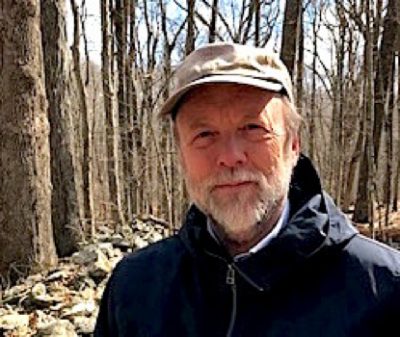
By Robert Thorson, Ph.D., Department Head
and Faculty Coordinator, Earth Science
We know that high school and college students are manifestly anxious about the current climate crisis. But how many also know that Earth isn’t fragile? That climate comes from underground? That ecology is only one part of earthly operations? That radioactive decay keeps our planet habitable? That petroleum is no less natural than water? That oxygen was originally an exhaust gas pollutant? That humanity’s most expensive mistakes involve ignoring the deep time of planetary history?

NASA Image of Earth from the International Space Station. Reid Weisman, Sept. 4, 2014.
It’s an ongoing and societally expensive tragedy that few U.S. citizens know how the Earth works as the whole pie, rather than pieces carved up into arbitrary disciplines. Typically, they were taught only nuggets of old-school geology in grades 8-10, rather than the mother lode of new school geoscience that remains undiscovered for most. I call this new school “whole earth environmentalism”, the idea that understanding how the planet works as a beautifully coherent integrated system is a prerequisite to best-practice management of the specific environmental problems that capture media attention.
UConn ECE is now offering an opportunity for students to learn about how it all works with a course that educates and also puts them on a pathway to important careers that will make a difference.
Meghan Kinkaid, UConn ECE Instructor from CREC’s Academy of Aerospace and Engineering, is a pioneer. This past year, she was the first instructor in Connecticut to offer UConn’s popular introductory geoscience course Earth’s Dynamic Planet (GSCI 1051). Her students now know that they are “impacted by geosciences daily and that this course gives us an opportunity to make them aware, take interest, and possibly plan a career around it.”
They’ve also learned that good jobs, high salaries, and rewarding careers are increasingly available, given the near-future shortfall of 175,000 geoscientists estimated by the American Geosciences Institute. Beginning with this UConn course offered through UConn ECE, the vast majority of UConn’s geoscience majors following one of three tracks (Earth, Environmental, Atmosphere) go on to successful scientific careers: mitigating natural hazards, improving risk assessments, restoring landscapes, accessing clean water, obtaining mineral resources, developing geothermal energy resources, science communication, and education.
The other high school teachers in Meghan’s pioneering cohort of UConn ECE-certified instructors—Lewis from the Hartford Magnet Trinity College Academy and both Christopher Tait and Harold Condosta from Ridgefield High School—were ready for takeoff last fall, but the chaos of the Covid-19 pandemic forced their administrations to delay. Five high schools, including New London High School and Plainfield High School, have certified instructors. Next year, four schools are scheduled to offer GSCI 1051. With school returning to in-person for the fall, Meghan McNichol (New London High School) quipped, “we won’t have to work twice as hard to accomplish half as much.”
Though Meghan Kinkaid is our pioneer, Kim Glazier, a science teacher from Plainfield, is our visionary. “Going forward,” she wrote, she “would like to see all of our AP classes replaced with ECE options.” AP or Advance Placement courses are those which high school students master content to “test out” of a college course during a grueling three-hour exam, provided the college accepts them, and they get a high score. UConn courses taught through UConn Early College Experience are those where the students experience the actual college course being taught in the comfort of their own school by a familiar teacher being supervised by a caring university or college faculty member. Kim’s vision aligns with our growing awareness that sit-down standardized testing is less accessible to under-represented groups, and less accurately reflects the diversity of approaches needed for STEM science careers. When reviewing the GSCI 1051 course description, Kim realized that UConn’s Earth’s Dynamic Planet “would meet the requirements of our required Integrated Science class and thought it would be awesome to offer a course that can lead to college credits for something the students have to take anyway.”
During our inaugural UConn ECE workshop of May 26, 2021, six of us—Meghan, Meghan, Jared, Harold, and me (with Kim included later)—bonded as a team dedicated to increasing the quality of geoscience education in Connecticut high schools. We invite you to join us by reviewing the GSCI 1051 course that unites us and contacting any of us for more information. As UConn’s ECE Coordinator for Geosciences, I’m a good first contact. I look forward to hearing from you.

Unsourced.
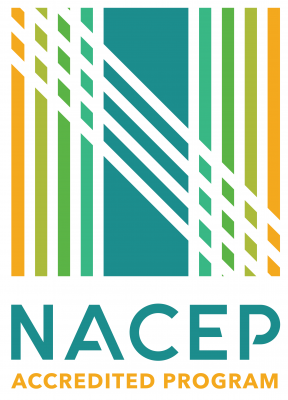
By Brian Boecherer
By the time you read this article, the National Alliance of Concurrent Enrollment Partnerships (NACEP) Re-accreditation application will have been submitted. Almost 900-pages of paired syllabi, assignments, statements of equivalency, analysis, documentation, and testimony from the four-corners of the program and the highest levels of the University. This has been my third time engaging in NACEP accreditation, with my first time in 2006 when UConn Early College Experience entered into its modern renaissance. When you complete a task as big as accreditation it feels important in many ways. No matter how experienced you are in the program, after leading an accreditation effort, you feel more knowledgeable than ever before. You have synthesized huge volumes of information, have lead many professionals in a very detailed way, and have created and edited hundreds of documents until you feel they are perfect. You are ready to lead the next chapter of the program, because you see how complete some areas are and where new opportunities should develop.
NACEP accreditation makes me very proud. Not only because we have the status of third-party review, but because our program shines in ways that few other programs do in the nation. As you have heard time and time again, UConn ECE is the oldest concurrent enrollment program in the nation. It is also really one of the best too. We are seen by others as an ivy league in terms of concurrent enrollment. Like the character of every person, our collective and constant efforts make us who we are. We are passionate and dedicated. We work hard and value the fruits of our labor. We care. This is not only true around accreditation time; it is true every year, all the time.
I remember when I started with the program full-time in 2005 (having really started with the program in 1999) and setting the development plan for the office through a process of visiting all the high schools in the program to learn what we did well and where we needed to improve. The high schools and the departments—our great community—put the issues on the table and we ran with them. NACEP was an important part of that story, because it helped us set goals, meet them, and then we aspired to surpass them. The drive to surpass them is part of our character and we should all be very proud to be part of that story.
As the director and the curator of the NACEP application, I know our re-accreditation package will be well-received. I also know that it took a community to create. It is the UConn ECE Community that creates the program, the accreditation package is a recording of your fine work. Thank you for all that you do, I am proud to be a part of this inspiring community.
By Carissa Rutkauskas
The UConn Early College Experience (ECE) community and the University of Connecticut publicly recognize and thank outstanding instructors and administrators whose dedication and commitment help make UConn ECE successful. Those recognized have exceeded program expectations and excelled in preparing their high school’s students for the next level in their education.
The UConn ECE Professional Recognition Awards Show premiered on YouTube on Thursday, May 13 in front of a live virtual audience. Ten instructors and administrators were spotlighted in the production, as well as UConn’s Associate Vice Provost, Peter Diplock, and many UConn undergraduate musicians. Congratulations to the recipients:
Thomas E. Recchio Faculty Coordinator Award for Academic Leadership
Anthony Rizzie, Mathematics, University of Connecticut
Principal Award for Program Support & Advocacy
Frances DiFiore, Cromwell High School
Site Representative Award for Excellence in Program Administration
Ka Man (Mandy) Cheung, Fairchild Wheeler Interdistrict Science Magnet School
Instructor Award for Excellence in Course Instruction
Dr. Thomas Vrabel, Sustainable Plant and Soil Sciences, Trumbull Regional Agriscience and Biotechnology Center
Margaret Kimmett, Chemistry, Valley Regional High School
Lalitha Kasturirangan, English, Eli Whitney Technical High School
Library Media Specialist Award for Excellence in Enrichment and Collaboration
Liza Zandonella, Newtown High School
“Rookie of the Year” Award for Excellence in First-Year Course Instruction
Kelsey Kapalczynski, Statistics, Wethersfield High School
Christopher Wisniewski, Biology, Berlin High School
Jan Pikul Award for Continued Excellence in Instruction
Aaron Hull, Political Science, Greenwich High School

By Jessica Dunn
The UConn Early College Experience (ECE) Office is very excited and proud to announce that we will be launching a “new to UConn” student registration system, DualEnroll.com, this fall. DualEnroll.com helps Concurrent Enrollment programs, such as UConn ECE, streamline and automate the enrollment of high school students in college courses. This improvement from a 5-step process has been a long time in the making. Our vision of a seamless online registration system and process is now a reality many thanks to the hard work and dedication of the UConn ECE community. We would like to extend a special thank you to University departments including the Office of the Registrar, Office of the Bursar, and UConn’s Information Technology Services as well as our high schools who instilled in us their trust and patience to improve the over student experience.
We would be remiss if we did not recognize and show our appreciation for the countless hours our high school Site Representatives and Instructors have dedicated to the student registration process in the past. Without their commitment to navigate the old registration system and assist students through the 5-step process, thousands of students could have missed out on the opportunity to participate in UConn courses while in high school.
In researching new registration systems, we were looking for a few very important features and found them all in DualEnroll.com. We are happy to be implementing the following major positive changes:
Dual Enroll.com will provide broader access to the high school students in Connecticut by eliminating the 5-step process that inadvertently lost students along the way, as well as provide a true college experience where students can easily register and then focus on the course material rather than the enrollment process. We are proud to implement a tool that will be true to our mission statement of providing access to, and preparation, for higher education.
We look forward to continuing to work with the UConn ECE Community to successfully launch DualEnroll.com and appreciate the support as we navigate the new system together!
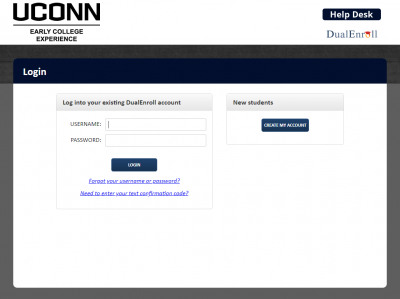
By Stefanie Malinoski
Robert Ford, a UConn Early College Experience American Studies (2013) and English (2007) Instructor at North Branford High School, was published in February in the National Council of English Teachers English (NCTE) Leadership Quarterly. His publication titled Adventures in Gamification and Personalized Learning: A Case Study in Game-Based Course Design is based on a gamification project he designed for his AMST 1201 course. You can connect with Rob on twitter at @robdford.
Katie Boland, a UConn Early College Experience Political Science Instructor (2011) at Trumbull High School, shared the success she and her students had as Connecticut State Champions at the We the People: The Constitution and the Citizen competition. She and her students then went on to rank 9th in the nation at the national competition in April.
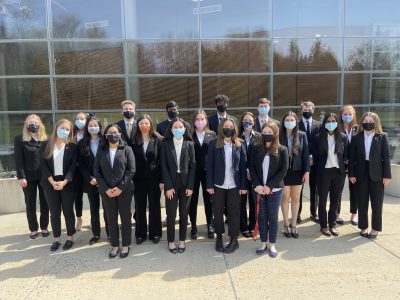
Trumbull High School We the People: The Constitution and the Citizen team at Nationals
Do you have accomplishments you’d like to share with the Early College Experience community in a future Magazine? We are always incredibly proud of our Instructors and their effort and the creativity they apply every day to their UConn courses and look forward to sharing more news of the successes of our Early College Experience community members.
Please share with us at ece@uconn.edu.
By Carissa Rutkauskas
At a recent combined UConn ECE Instructor Professional Development Workshop between American Studies, Latino and Latin American Studies (LLAS), and US History, Dr. Anne Gebelein (Professor and UConn ECE Faculty Coordinator of Latin American Studies) presented Mass Deportation – A Nation Controls Its Identity. She offered a deep dive into mass deportation, and the ethnic politics of moving a lot of people where they don’t want to go. The presentation was well- received, and many Instructors found it extremely relevant to their current UConn courses. Hoping to share the information with her UConn ECE Students at New Fairfield High School, UConn ECE American Studies Instructor Karon McGovern reached out to Dr. Gebelein with a request – would she offer the live online presentation to her class? Dr. Gebelein was pleased to offer it to Karon’s students at New Fairfield, as she regularly lectures for her LLAS ECE instructors in schools such as Manchester , E.O. Smith in Mansfield, and Branford High Schools. This past year, she offered lectures on cyclical violence in Central America, human rights at the US/Mexico border, and on her most recent lecture, Latino and Puerto Rican activism and social organizing.
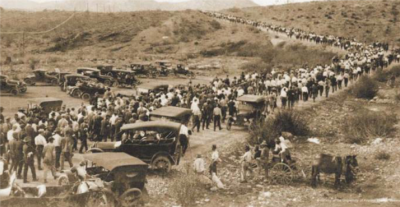
“I am lucky to have such a dedicated group of teachers in Latin American Studies – I learn as much from them as they do from me,” said Dr. Gebelein. “As we are a small group, it is possible for me to guest lecture at least once a year in each classroom and model for teachers what I consider a solid college-level lecture. Given that I also have the pleasure of observing them in action in the classroom, as they model their own creative approaches to the history, culture and literature of Latin America, it is a wonderful exchange of teaching knowledge. I feel privileged to be able to be inside the classroom of so many talented instructors.”
Dr. Gebelein’s presentation on mass deportation provided an overview of deportation in general, vocabulary around deportation, consequences of deportation, within a critical race theory framework. The primary focus was of the deportation of Mexican and Mexican-Americans during the Great Depression and during “Operation Wetback” of 1954. An examination of the history leading up to these removals of Mexican-looking peoples reveals a stage long set for drastic action, as the precedent of systemic racism was established in the Mexican-American War that ended in 1848. The following summarizes this prelude as well as the thrust of her presentation.
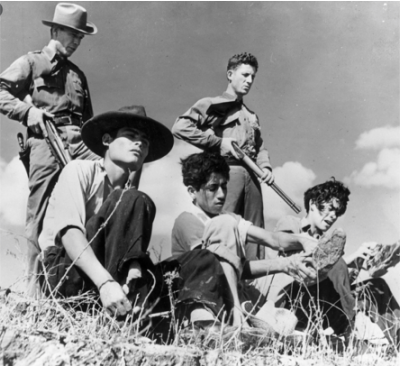
The Mexican American War (1846 to 1848) and subsequent Treaty of Guadalupe Hidalgo resulted in the US annexation of Texas and land that makes up all or parts of present-day Arizona, California, Colorado, Nevada, New Mexico, Utah and Wyoming. Mexicans did not cross the border, but rather, the US border crossed Mexico. Due to the shift in the political boundary, Mexicans who found themselves suddenly part of the US were considered a colonized people and their land open for repossession as part of spoils of war. After some debate, US officials decided to consider these new members of the nation “white” and to grant them federal citizenship to appease Mexican peace treaty negotiators and elicit their cooperation in fighting Indians. This move created a color shift in the evolution of distinct racial logistics, making lesser whites (Italians and Irish), “more white” in a nation trying to maintain itself as white and Protestant. This “whiteness” was in competition with strong populations of Black, Native American, and Chinese people, in addition to the Irish, Italian, and increasingly Mexican populations, the latter largely Catholic.1
After the war, white settlers migrated west onto the newly acquired land, resulting in grand-scale disenfranchisement through tactics that included:
Emboldened by the success of their expansion and domination of Mexican land and peoples through violence, yet dependent on Mexican labor for food, transport, and wealth generation, US government officials began to debate the value of Mexicans as “lesser whites” who were disposable laborers, who could be sent to Mexico should their labor no longer be needed. The challenge was that many officials could not distinguish Mexican Americans from Mexicans.
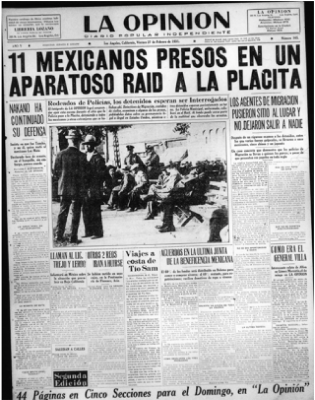
Soon after the stock market crash of 1929 and the resulting Great Depression, the US began deporting “Mexican-looking” people in an effort to alleviate unemployment and welfare rolls and maintain “Jobs for real Americans.” These efforts included coercion tactics leading to “self-deportation” and raids, resulting in relocating Mexican citizens back to their country, and the mistaken deportation over a million US citizens.3

Diego Rivera, “Detroit Industry Frescos”
Not even 25 years later the US began Operation Wetback (1954), a deportation strategy primarily targeting the Bracero Program (1942-1964). The Bracero Program, a federal program designed to provide necessary male manual labor during World War II, welcomed 4.6 million Mexican workers to the US. Over the years, unsponsored wives and children joined their husbands, as did undocumented brothers, cousin, and friends. Texas’s refusal to participate in the program added to additional undocumented workers. The US launched a campaign of stereotypes and propaganda visualizing Mexicans as child-like to encourage communities to round up for deportation 1.3 million workers and family members, many of them US citizens.4
Dr. Gebelein then used the historical context of this harsh and callous treatment, and creation of policy and laws against Mexicans and Mexican Americans, to draw parallels to current topics of containment and racialization in the United States.
UConn ECE is grateful for Dr. Gebelein’s expertise and willingness to extend her research to her Instructors. She is a shining example of how UConn ECE Faculty Coordinators not only provide academic guidance to their discipline’s UConn ECE courses, but are an invaluable resource in sharing their research and knowledge.
1 summarized from Gebelein presentation
2 quoted from Gebelein presentation
3 according to the research of Joseph Dunn, former CA state senator
4 summarized from Gebelein presentation
“I teach AMST1201 at New Fairfield High School through the lens of race and gender issues in America spanning the 20th and 21st centuries and, within the context of race, I am constantly striving to recognize the many different people who have been, and continue to be ‘othered’ in our country. I ‘met’ Anne when I attended an UConn ECE professional development session when she delivered a history of the treatment of Latinx people in America. From the title slide, “Mass Deportation” I was captivated, as I use the text Michelle Alexander’s The New Jim Crow, a commentary on mass incarceration in America. I approached Anne to speak at our school, virtually, and she enthusiastically accepted. To say my students were stunned to learn this part of the history of their country, would be an understatement. I feel Anne should do a roadshow around Connecticut schools, delivering this important information, to educate students and beyond, that ‘walls do not a tolerant society make’.”
Dr. Gebelein concluded. “UConn ECE Instructors’ work is more important than ever, in a country in which we have recently seen legislation introduced in multiple states to bar teachers from teaching slavery and from critically theorizing about race. We have to be brave enough to tell the truth about hard history, as it teaches students to recognize the harm that comes from reproducing old ethnic divides, as well as the value of building ethnic coalitions.”
By: Claudia Koerting, UConn ECE Faculty Coordinator, Marine Sciences
The annual Marine Sciences Symposium took place again this year, even though it looked a bit different than in past. The symposium featured student research that has been conducted over the academic year. This year over 80 students from six high schools joined in WebEx to present their work. The students who presented at the symposium are currently enrolled in MARN1003: Introduction to Oceanography with Laboratory or MARN 1001E: The Sea Around Us. The MARN 1003 students demonstrated the true experiential nature of the course by applying the fundamentals of oceanography to their field work and laboratory experiments. In addition, one Marine Science Magnet High School of Southeastern CT student enrolled in MARN 1001E presented on human interactions with the marine environment. The high involvement in this event was a testament to the dedication and creativity of high school teachers and the commitment of their students to find ways to meet and “do” science.
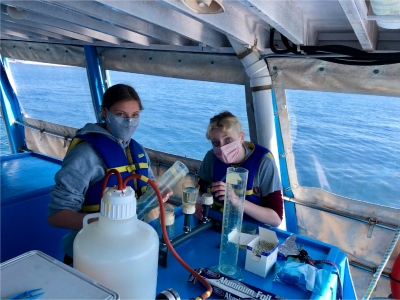
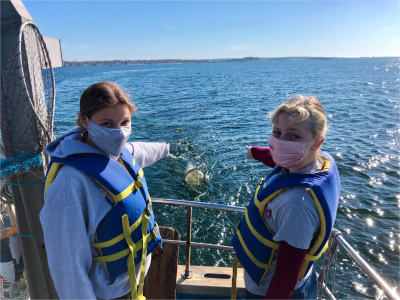
While some teachers, such as Mrs. Emily Lisy from the Morgan School and Mr. Kirk Shadle from The Bridgeport Aquaculture School were able to meet with their students regularly, others had to get creative. There was a presentation on methods for disrupting harmful algal blooms, as well as a study on shark behavior and how to entice bivalves to consume starch based microplastics. The Morgan School took advantage of their proximity to the water and went on field trips to conduct field sampling and analyses on Long Island Sound ecosystem quality. Ledyard High School students conducted thoughtful sampling on the Thames River and the shoreline for microplastics. Even though they had to analyze their samples either at home or safely spaced apart in school, they were still able to yield very interesting and surprising results. Mrs. Laura Francis’ Coginchaug High School students also presented very impressive research in the face of multiple hurdles throughout the year. What do basil and raising tilapia have in common? A Coginchaug High School student can tell you through his sophisticated hydroponics experiment he conducted at home! Lastly, Mrs. Kathy Howard’s student from her MARN1001 course did an outstanding job presenting on the state of plastics in the world’s oceans.
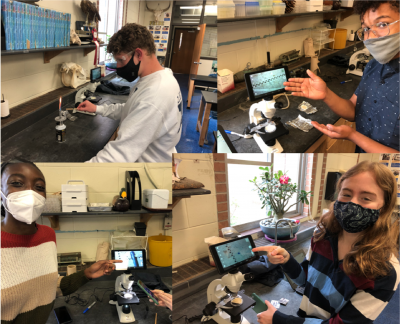
After hearing all the great research that has gone on this year in the morning presentations, the day concluded with Mr. Mike O’Conner’s Waterford High School students who introduced a community service component of their yearlong project with a 20-minute recording. The inspirational project showed students who are working with the town of Waterford to develop signage for Alewife Cove in Waterford. The signage includes information on the ecology of the marsh, its importance, and threats to its existence. Students have also proposed a new kayak launch to help protect the marsh.
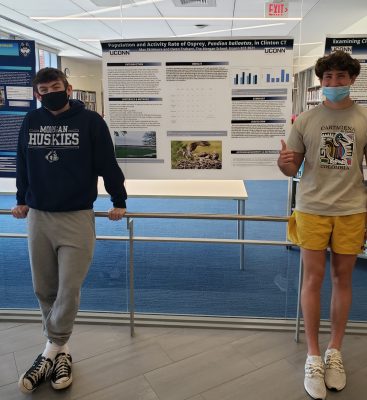
This year, presenting a group project virtually at the Symposium made the most of limited time the students could be together. Even with all the obstacles the students faced this year, their work was very impressive. We appreciate the flexibility and willingness of the instructors and students to make this virtual format a success, and we look forward to next year when we can once again spend the day at UConn’s Avery Point campus together!

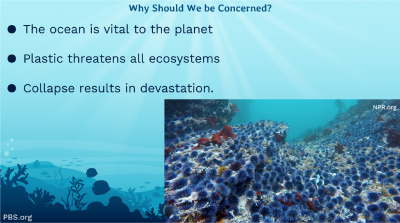
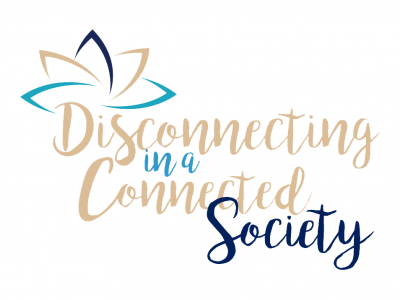
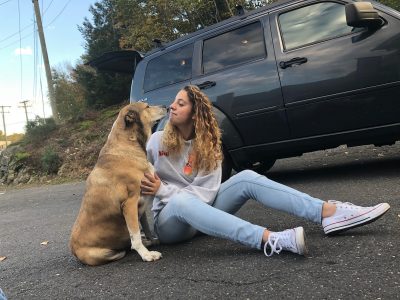
Nicole Bartlett
Southington High School
LLAS 1190: Introduction to Latin America and the Caribbean
When I need to disconnect from a connected society I spend time volunteering at my local dog pound. I have been a volunteer at the Wolcott Dog Pound for the past 8 years. I enjoy working fundraising events, fostering dogs, and meeting the everyday needs of those dogs who have entered the pound. They have been abused, abandoned and neglected. My goal is to help them trust again, be their voice, and find their forever home.

Olivia Olbrias
Windham Technical High School
HIST 1502: United States History Since 1877
In today’s society we are frequently stuck to our computers because of online classes. After a long day of sitting at my laptop I like to get outside and disconnect for a bit, I tie up my skates and play some music and get active! My picture represents disconnecting by showing a healthy activity that needs no technology at all!
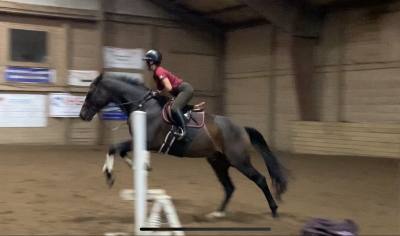
Min Silva
Ledyard High School
ANSC 1602: Behavior and Training of Domestic Animals
To disconnect from society, I like to ride horses and take in the calmness that they give off.
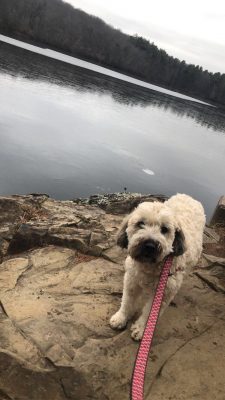
Alexa Davidson
Sacred Heart Academy
FREN 3250: Global Culture I
My favorite way to disconnect from technology is by taking my dog on hikes. It is a fun and enjoyable way to spend some time in nature and bond with my fluffy friend!
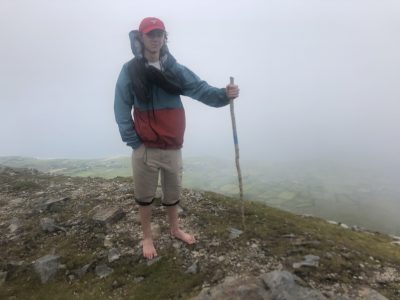
Cam Begley
Suffield High School
NRE 1000E: Environmental Science
Hiking is a great way to unplug from phones, TVs, and even other people. Instead, you can see, feel, and appreciate the natural beauty of our planet… and it’s that much better barefoot! This picture is of me at the top of Croagh Patrick mountain in Ireland; I climbed it barefoot to participate in the tradition of making a centuries-old pilgrimage to the summit.

Isabella Maglio
Plainfield High School
AMST 1201: Seminar in American Studies
This photo represents disconnecting in a connected society because nature photography is my escape. There is so many beautiful things that the world offers if we were just to take a break from social media and take it all in!
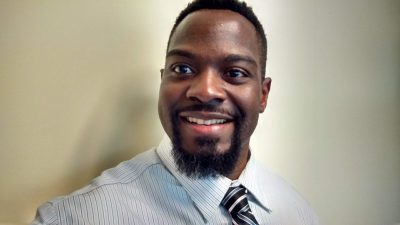
By Clewiston Challenger, Ph.D., School Counseling Program,
Neag School of Education
The Centers for Disease Control (CDC) recently issued updated guidelines for schools for the upcoming academic year. They recommend schools to fully open and students to return to in-person learning. The updated guidelines signal a return to a new normal as it pertains to learning in a school building. These recommendations are in contract to those of the pandemic which forced a national lockdown, disrupting students’ learning, and turning homes into classrooms. Though the transition back will not come without challenges, school administrators can ease the transition by utilizing school counselors to advise them on ways to reopen their doors safely and effectively to welcome students back. You see, school counselors and other student support services (i.e. social workers, school nurses, school psychologists, school-based community organizations) are trained to provide counseling services to support students’ mental health, wellness, and personal-social development to increase academic performance. As schools emerge from the effects of the national lockdown due to COVID-19, school counselors are poised to serve as consultants and collaborators who can inform the rebuilding process of the school culture while planning for future crisis.
The opportunity within the opportunity
School counselors are boots on the ground-types of practitioners. These practitioners are usually in the halls, moving about the school, mingling with students and staff, all to be in tune with the school climate. This approach of having boots on the ground, creates roots in the ground by skillfully forming collaborative relationships with students, staff, and families. This type of relationship-building approach can help students—and staff—root themselves back into the school culture to feel welcomed and more involved. Counselors and other student support personnel should focus their efforts on students’ sense of belonging, resiliency, and their motivation towards school and academics. The opportunity has arrived for school counselors to sit at the table with administrators to offer their ideas on how to redesign the school environment and student achievement.
School counselors need to innovate to motivate
Transitioning to remote learning, for many, was cumbersome and inconvenient. Constant adjustments were needed to enable remote instruction to moderately garner student engagement, and school counselors were not exempt from this “clunky” transition. Like other educational professionals, school counselors had little to no guidance on how to effectively provide counseling services virtually. So, as in-person learning returns, school counselors need to creatively think about how to motivate students to return to school. A newly designed comprehensive school counseling curriculum should be school-wide, relevant and responsive, as well as inclusive. One that allows students to feel heard and cared for and stimulates academic engagement. It is also important that turf wars between student support services ends, replacing it with a vision of unified services. School counselors should collaboratively work with other disciplines as futurist planning for potential crises and how to deliver services without delay or disruption.
Putting it into perspective
First, it must be acknowledged that communities of color were deeply impacted by the effects of the pandemic and the lockdown in comparison to their White counterparts. Communities of color saw greater rates of illness, death, and financial hardship due to the COVID-I9 virus and the effects of the lockdown. School counselors would benefit from continuing their education around cultural competency as well as diversity training to successfully serve this population. In addition, school counselors should consider focusing on the noncognitive needs of their students which could lead to positive student adjustment, behavior, retention, and graduation rates in a post-pandemic era. More students having a positive outlook in these areas could lead to higher involvement in the school, community, and their homes.
So, as we return to the classroom in the fall for in-person learning, importance should be placed on providing support for students’ mental health and wellness as they reengage in the traditional learning process. School counselors can use the lessons learned from the pandemic to introduce new ideas to create an engaging and inclusive learning environment. We can agree that COVID-19 has changed the landscape of education and has caused us to consider new ways on how to instruct, counsel, and engage our students. There may be long-lasting traumatic effects from the lockdown and remote learning that could have a negative impact how students and staff return to the in-person setting. Research has shown that students have better academic performance and social interactions with peers when they have stable mental health and their noncognitive needs are met. It would benefit school counselors to prioritize addressing these areas to help students adjust to being in the building again. Additionally, school counselors have the opportunity to take on leadership roles in their schools, district, and community to use their influential voice for their innovative ideas on how to increase student involvement in the school and student motivation. These practitioners are best positioned to efficaciously implement these ambitious initiatives due to their specialized training and skillset, cultural competency, and collaborative approach to student and family service. Counselors, let’s go to work!